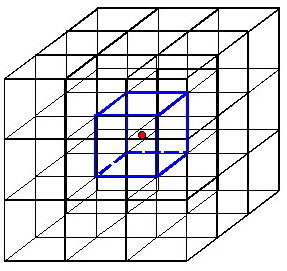
The Presence- & the Homogeneity-Acceleration ([1]) are two different but similar approaches which are basing on Importance Sampling. Importance Sampling means concentrating most of the samples in that portion of the volume which contributes most to the value. The Presence-Acceleration uses the principle of the Hierarchical Enumeration but introduces also an error, which means as large as possible nearly empty sections are grouped together and are approximated with an average value for this section. For the realization a max27 and an average pyramid is used. The Homogeneity-Acceleration uses the principle of Hierarchical Splatting, but here for raycasting, which means as large as possible homogeneous sections are grouped together and are also approximated with an average value. The homogeneity is adjustable and affect an associated error. For the realization a range27 and also an average pyramid is used.
The max27 pyramid is a special case of a maximum pyramid, because a new data point depends not only on the maximum of the 8 replaced voxels, but also on the maximum of the 26 surrounding cells, so 64 data points affect the new value. If you use the max27 pyramid with opacities you can find nearly empty sections in the volume, which have a small maximum opacity.

Analogous is the min27 pyramid defined. In the range27 pyramid every node contains the Manhattan-distance of the corresponding nodes in the max27 and the min27 pyramid. As you can see in the definition of the Manhattan-distance, which is the sum of the absolute differences of the color channels and the opacity, the Manhattan distance in a node is a measure for homogeneity in the represented subvolume. The smaller a value in the range27 pyramid, the more homogeneous is the respective section and vice versa.
Manhattan distance:
MH(a,b) = (|a.r - b.r| + |a.g - b.g| + |a.b - b.b| + |a.alpha - b.alpha|)/4For rendering a user-specified error is chosen, which makes progressive refinement possible. For Presence-Acceleration the max27 pyramid is traversed from the top until the maximum opacity for every subvolume is less equal than the specified error and these subvolumes are approximated with the average values for RGB and alpha in the corresponding nodes in the average pyramid. The algorithm for the Homogeneity-Acceleration is the same, except that the range27 pyramid is used for the traversal instead of the max27 pyramid, so you can group together homogeneous subvolumes.